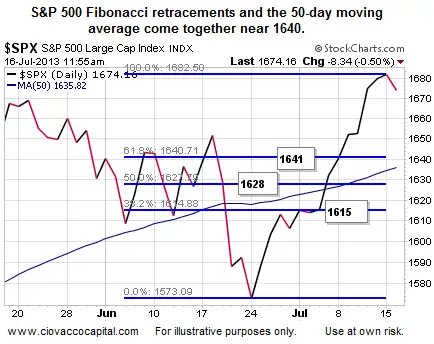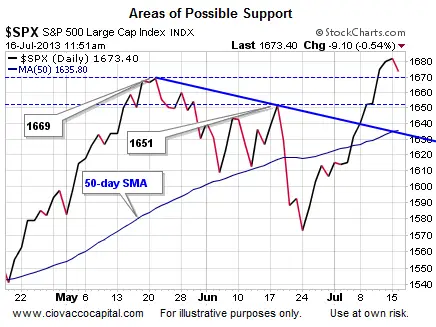Up until recently we rarely heard the word “tapering” but now it seems to be everywhere. Why? Because in June FED chairman Ben Bernanke floated a “trial balloon” and mentioned “tapering”. By this he meant that he was considering slowly closing the faucet that is currently gushing easy money, i.e. $85 billion a MONTH. The stock markets promptly had a temper tantrum and Bernanke blinked and said, oh I was only kidding… I will eventually have to scale back but it won’t happen any time soon… don’t worry. He also said that the Fed’s 6.5% target for US unemployment should be considered a “threshold, not a trigger” and that the FED would continue to support the economic recovery, “even as the pace of recovery is picking up”.
In an attempt to reassure investors, he used a driving analogy saying, the Fed will behave like a driver “letting up on the gas peddle as a car picks up speed”, i.e. don’t worry we won’t slam on the brakes. He also left himself an out saying, that the tapering plan is not set in stone and can be adjusted at any point depending on whether America’s economic recovery meets expectations.
But based on the anemic recovery which is almost exclusively due to easy money, it is difficult to see how he will be able to keep the stock market afloat and taper at the same time. Today Chris Ciovacco looks at the market with all this tapering and inflation talk. Personally, I think all the concern over the renewing in inflation is currently overdone. The increase in the annual inflation rate is primarily because a negative number fell out of the calculation. We have one more to go and then the inflation rate will fall again. See our Moore Inflation Predictor for more information.~Tim McMahon, editor
Will Rising Inflation Renew Tapering Debate?
by Chris Ciovacco, Ciovacco Capital Management
Inflation Higher Than Expected
The if/when associated with the Fed’s plan to taper its bond purchases got a “sooner rather than later” economic data point Tuesday. As we noted Monday, one of the fears within the Fed is for their unprecedented campaign of money printing to eventually lead to higher than anticipated consumer prices. From Reuters:
The Labor Department said its Consumer Price Index increased 0.5 percent, the largest rise since February, after nudging up 0.1 percent in May. Gasoline prices accounted for about two thirds of the increase in the CPI. Economists polled by Reuters had expected consumer inflation to increase 0.3 percent last month. In the 12 months through June, consumer prices advanced 1.8 percent after rising 1.4 percent in May. It was also the largest increase since February.
Markets Do Not Move Straight Up
The S&P 500 was down 7 to 9 points in late morning trading Tuesday. Given the S&P 500 has gained 124 points over the last three weeks, some “give back” is normal and to be expected. Traders monitor Fibonacci levels since they can offer clues to areas where buyers may again surface during a pullback. The chart below shows the retracement levels based on the June 24 closing low and July 15 closing high.

Earnings: No Warm Reception Tuesday
Goldman Sachs (GS) beat earnings expectations, but was still down over 1% around lunch time Tuesday. The mid-day bias seemed to skew bearishly when it came to earnings. Even a rosy report from Johnson & Johnson (JNJ) elicited a relatively tame response. From Bloomberg:
Coca-Cola (KO) fell 2.2 percent as the beverage company said volumes missed estimates amid slowing economic growth. Cintas (CTAS) dropped 2.3 percent after the uniform maker forecast earnings for the current fiscal year that were below estimates. Goldman Sachs (GS) lost 1.2 percent even after profit beat analysts’ projections. Johnson & Johnson added 0.3 percent as profit more than doubled and the company boosted its earnings forecast.
What Once Was Resistance
Traders have a time-tested expression what once was resistance may now act as support. Based on that simple premise, if the tapering and earnings induced selling continues, the S&P 500 could find buying support near 1669 (May high), 1651 (June high), or 1630ish (blue trendline recently broken).

Investment Implications
After seeing the S&P 500 add 124 points in three weeks, it may be time for a healthy pullback. However, as noted on Twitter, the market is not always cooperative for those with large stashes of cash.

The market seems to have digested the tapering message from the Fed allowing for a bullish bias over the past three weeks. Our weekend video noted the technical bias is bullish from an intermediate-term perspective (several weeks). As long as that tapering bias remains intact and the technical trend is up, we will hold our broad U.S. positions (SPY) and leading sectors, such as small caps (IWM), financials (XLF), and technology (QQQ) through any “give back” that remains within the realm of normal.
See Also:
- What is the Real Definition of Inflation?
- What to Do When – Not If – Inflation Gets Out of Hand
- Why Inflation is U.S. Hottest Export






Leave a Reply